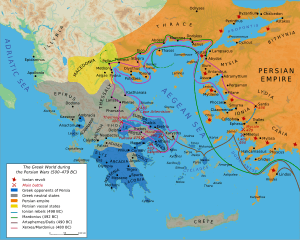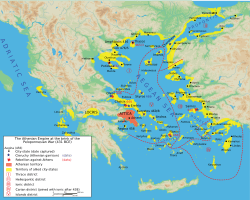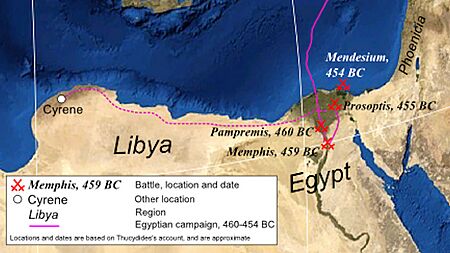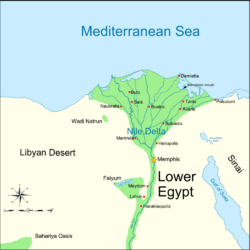Wars of the Delian League facts for kids
Quick facts for kids Wars of the Delian League |
|||||||||
|---|---|---|---|---|---|---|---|---|---|
| Part of the Greco-Persian Wars | |||||||||
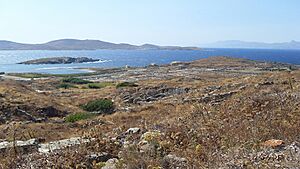 The ruins of Delos, location of the treasury of the Delian League until 454 BC |
|||||||||
|
|||||||||
| Belligerents | |||||||||
| Delian League Egyptian rebels (until 454 BC) |
Persian Empire and allies | ||||||||
| Commanders and leaders | |||||||||
| Pericles Charitimides † Cimon † Inaros II (POW) |
Xerxes I Artaxerxes I Artabazus Megabyzus |
||||||||
| Casualties and losses | |||||||||
| 250 ships 50,000 men |
200 ships (Battle of the Eurymedon)+++ | ||||||||
The Wars of the Delian League (477–449 BC) were a series of battles. They were fought between the Delian League, led by Athens, and the powerful Achaemenid Empire of Persia. These wars were a continuation of the larger Greco-Persian Wars. They happened after the Ionian Revolt and the two big Persian invasions of Greece.
After the second Persian invasion of Greece was defeated, the Greek alliance, led by Sparta and Athens, kept fighting. They captured Persian bases in Thrace in 479 and 478 BC. But after taking Byzantium, Sparta decided to stop fighting. So, a new group called the Delian League was formed. Athens quickly became the main leader of this new alliance. Over the next 30 years, Athens became even more powerful. The Delian League slowly turned into what is now called the Athenian Empire.
Contents
Understanding the Timeline
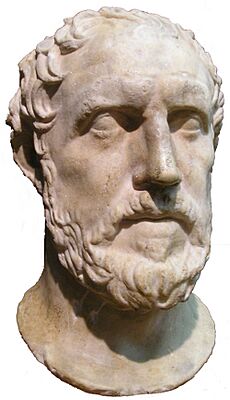
Historians learn about this period from old writings. The most important one is History of the Peloponnesian War by Thucydides. He was alive during these wars. His writings help us understand the main events, even though he didn't give many exact dates.
Other writers like Plutarch and Diodorus Siculus also wrote about this time. They add more details, but they wrote much later. So, historians use all these sources, plus old records and archaeological finds, to figure out what happened and when.
For example, we know the siege of Thasos started around 465 BC. This helps us place other events, like the Battle of Eurymedon, around 469 BC or 466 BC. The war in Egypt is easier to date. It lasted six years, from about 460 BC to 454 BC. A five-year truce with Sparta followed in 451 BC. The last campaign in Cyprus happened right after, from 451 BC to 450 BC.
Why the Wars Started
The wars between Greece and Persia began because Persia had taken over Greek cities in Asia Minor. These cities, especially in Ionia, found it hard to be ruled by Persia. Around 500 BC, they rebelled in what was called the Ionian Revolt.
Athens and Eretria helped the Ionians. They even helped burn the Persian city of Sardis. After the revolt was crushed, the Persian king Darius the Great wanted to punish Athens and Eretria. He also wanted to stop other Greek states from threatening his empire. This led to two big Persian invasions of Greece.
The first invasion ended with the famous Greek victory at the Battle of Marathon in 490 BC. Darius's son, Xerxes I, led the second invasion in 480 BC with a huge army. The Greeks fought bravely at Thermopylae and Artemisium. But Persia took over most of Greece. Then, the Greeks won a major naval battle at Salamis. The next year, in 479 BC, the Greeks defeated the Persian army at the Battle of Plataea. This ended the Persian threat to Greece.
On the same day as Plataea, the Greek fleet also defeated the Persian fleet at the Battle of Mycale. This victory freed the Greek cities in Asia Minor. The Greeks then captured the Persian town of Sestos and later Byzantium. But the Spartan general, Pausanias, upset many allies. So, Sparta decided to leave the war effort. This is when Athens took over leadership.
The Delian League is Formed
After Sparta left, a meeting was held on the holy island of Delos. A new alliance was formed to keep fighting Persia. This alliance was called the 'First Athenian Alliance', but we know it as the Delian League. Its main goal was to "avenge the wrongs they suffered by ravaging the territory of the king." This meant:
- Getting ready for any future Persian attacks.
- Getting revenge on Persia.
- Sharing any treasures or spoils from the war.
Members of the League could either send soldiers and ships or pay money to a shared treasury. Most states chose to pay money. They swore an oath to be allies forever. The Athenian leader Aristides spent his life helping manage this alliance.
Expanding the League
The Delian League didn't just fight Persia. It also grew by adding more members, sometimes by force.
- Karystos: This city had helped the Persians before. The League attacked it in the 470s BC and forced it to join.
- Phaselis: During the Eurymedon campaign, the Athenian general Cimon made Phaselis join the League.
Rebellions Within the League
Some members tried to leave the League, but Athens stopped them.
- Naxos: Around 470 BC, Naxos tried to leave. Athens attacked and forced it to stay.
- Thasos: In 465 BC, Thasos also tried to leave. Athens defeated them and made them stay.
These actions showed how powerful Athens was becoming. The Delian League was slowly changing from an alliance into the Athenian Empire.
Conflicts in Greece
During this time, the Greek states on the mainland were mostly at peace with each other. But Sparta became worried about Athens's growing power. This fear eventually led to the First Peloponnesian War between Athens and Sparta.

In 462 BC, Athens sent troops to help Sparta with a revolt. But Sparta sent the Athenians home because they feared Athens might interfere. This made Athens angry and led to the removal of Cimon, a leader who favored Sparta. New leaders like Pericles came to power, and the war between Athens and Sparta began.
The Delian League members had agreed to fight Persia, not other Greeks. But some Ionian soldiers did fight with Athens in battles like the Battle of Tanagra.
The war in Greece also sped up the change of the Delian League into the Athenian Empire. In 454 BC, after a big defeat in Egypt, Athens moved the League's treasury from Delos to Athens. This showed that Athens was now fully in control.
Battles Against Persia
Campaigns in Thrace
The League's first big campaign was against the city of Eion in Thrace. This city was a Persian base. The goal was to remove all Persian presence from the region.
Siege of Eion
The Athenian general Cimon led the attack on Eion. He defeated the Persians in battle, then besieged the city. Cimon cut off food supplies to starve the Persians. The Persian commander, Boges, refused to surrender. He threw his treasures into the river, killed his family, and then himself. The Athenians captured the city and enslaved the people.
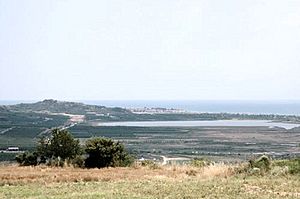
After Eion fell, other coastal cities joined the Delian League. The Persians eventually left their last stronghold in Europe, Doriscus, around 465 BC.
Skyros
After Eion, Cimon also attacked the island of Skyros. This wasn't against Persia, but against pirates who lived there. Athens "freed the Aegean Sea" from pirates and sent its own people to live on the island.
Chersonesos
About ten years later, Cimon returned to finish clearing Persian forces from Europe. This happened around 465 BC. Cimon captured Persian ships and drove them out of the Chersonesos peninsula. He then gave the land to Athens for its citizens to settle.
Campaigns in Asia Minor
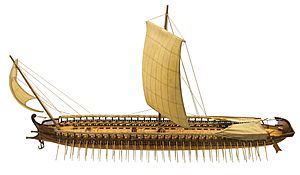
Once Persia was mostly gone from Europe, Athens started expanding the League in Asia Minor. Many Greek cities there joined the League.
Cimon's campaign in Asia Minor began because Persia was gathering a large fleet and army at Aspendos. It seemed Persia was planning a new attack. Cimon sailed with 200 warships to stop them. He first made the city of Phaselis join the League. This blocked the Persian plan to move along the coast. Then, Cimon decided to attack the Persian fleet directly.
Battle of the Eurymedon
The Persian fleet was waiting for more ships from Cyprus. Cimon attacked before the reinforcements arrived. The Persians tried to retreat into the Eurymedon River, but Cimon forced them to fight. The Greek ships quickly broke through the Persian lines. The Persian sailors ran their ships aground and fled to their army on land.
Even though his troops were tired, Cimon landed his soldiers and attacked the Persian army. The Greeks, with their heavy armor, defeated the Persians. Thucydides says 200 Persian ships were captured and destroyed. Plutarch adds that Cimon then sailed quickly to intercept the 80 Phoenician ships Persia was expecting. He surprised and destroyed them all.
The Battle of Eurymedon was a huge victory for the Delian League. It probably ended any threat of another Persian invasion of Greece. It also stopped Persia from trying to take back the Greek cities in Asia Minor for a long time.
Campaign in Egypt
The Egyptian campaign began around 460 BC. Athens was already fighting Sparta at this time. But Athens saw a chance to weaken Persia. Egypt was often rebelling against Persian rule. In 461 or 460 BC, a new rebellion started under a Libyan king named Inaros. He asked the Delian League for help.
Athens sent a fleet of 200 ships, led by Admiral Charitimides, to Egypt. They sailed up the Nile River to join Inaros. Charitimides defeated a Persian fleet of 50 Phoenician ships, destroying 30 and capturing 20. This was the last big naval battle between Greeks and Persians.
The Persian king Artaxerxes I sent a large army to crush the revolt.
Battle of Papremis (460 BC)
The Persian army set up camp near the Nile. The Athenians and Egyptians attacked them. At first, the Persians had more soldiers, but the Athenians broke through their lines. The Persian army ran away. Some Persians found safety in a fort in Memphis, called the 'White Castle'.
Siege of Memphis (459–455 BCE)
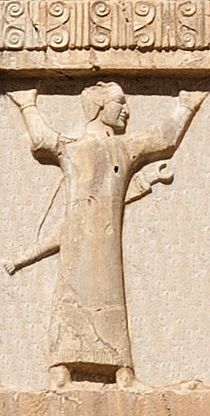
The Athenians and Egyptians then tried to capture the White Castle. The siege lasted about four years. The Persian king first tried to bribe Sparta to attack Athens, but it didn't work. So, he sent a huge army to Egypt.
When the Persian army arrived, they quickly broke the siege of Memphis. They defeated the Egyptians and drove the Athenians away from the city.
Siege of Prosopitis (455 BCE)
The Athenians retreated to an island called Prosopitis in the Nile delta, where their ships were. The Persians besieged them there for 18 months. Finally, the Persians dug canals to drain the river around the island, connecting it to the mainland. The Persians then attacked and captured the island. Only a few Athenians escaped and made it back home.
Battle of Mendesium
To make things worse, a group of 50 Athenian ships was sent to help the besieged forces. But they arrived too late. The Persian army and Phoenician navy attacked them at the mouth of the Nile. Most of these ships were destroyed, and only a few escaped. In total, Athens lost about 50,000 men and 250 ships in this disastrous Egyptian campaign.
Campaign in Cyprus
In 478 BC, the Greeks had sailed to Cyprus and taken control of most of the island. But they didn't keep it. The Delian League fought in Cyprus again around 460 BC, before their fleet was sent to Egypt.
After the disaster in Egypt, Athens signed a five-year truce with Sparta in 451 BC. This freed up their forces. So, the League sent a fleet to Cyprus again in 451 BC, led by the general Cimon.
Siege of Kition
Cimon sailed to Cyprus with 200 ships. However, 60 of these ships were sent to help an Egyptian rebel leader. The rest of the fleet besieged the city of Kition in Cyprus. During the siege, Cimon died from illness or a wound. The Athenians were running out of supplies. They decided to retreat towards Salamis-in-Cyprus.
Battles of Salamis-in-Cyprus
The Athenian army kept Cimon's death a secret. Thirty days after leaving Kition, they were attacked by Persian forces (from Cilicia, Phoenicia, and Cyprus) near Salamis-in-Cyprus. Even without Cimon, the Athenians won both a sea battle and a land battle. This allowed them to escape and sail back to Greece. The ships that had gone to Egypt also rejoined them.
These battles marked the end of the long Greco-Persian Wars.
Peace with Persia
After the battles in Cyprus, the fighting between the Greeks and Persians stopped. Some ancient historians say a peace treaty, called the "Peace of Callias," was signed. This treaty would have officially ended the Greco-Persian Wars.
The terms of this possible treaty were:
- All Greek cities in Asia Minor would be free and rule themselves.
- Persian armies and warships would stay far away from the Aegean Sea.
- In return, Athens would not send troops into lands ruled by Persia.
Modern historians are not sure if this treaty truly existed. Some believe it did, others think it was just an agreement without a formal treaty. Either way, it seems that after 450 BC, there was no more open conflict between the Delian League and Persia for many years.
What Happened Next
As the wars with Persia ended, the Delian League had fully become the Athenian Empire. Athens did not let its allies leave the League, even though the main goal of fighting Persia was over. The allies still had to pay money or provide ships to Athens.
In Greece, the First Peloponnesian War between Athens and Sparta ended in 445 BC with a 30-year truce. But the rivalry between Athens and Sparta grew. Just 14 years later, the much bigger Peloponnesian War began. This war lasted 27 years and completely destroyed Athens's power and its empire. It also weakened all of Greece.
After 450 BC, Persia changed its strategy. Instead of fighting the Greeks directly, the Persian kings tried to cause trouble between Athens and Sparta. They often bribed Greek politicians to keep the Greek states fighting each other. This way, the Greeks were too busy with their own conflicts to threaten Persia.
This period of Greek infighting allowed Persia to regain some power. In 387 BC, Sparta even asked Persia for help during the Corinthian War. Under a treaty called the "King's Peace," Persia demanded and received control of the Greek cities in Asia Minor again. This was a humiliating moment for the Greeks. It showed how much power they had lost since the time of the Delian League.


